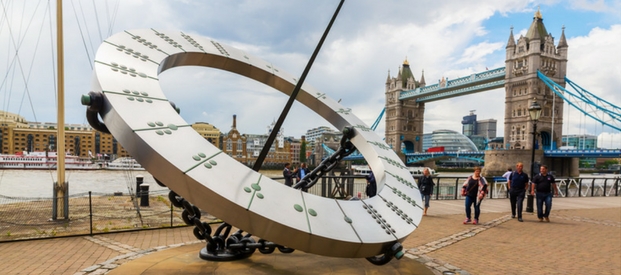Do you know the difference between Clock Time and Sun Time?
Who knew there was a difference between time measured on sundials and the actual time from the position of the sun in the sky? Did you realise it’s not necessary therefore to adjust sundials forwards or back an hour, even if you could? Here we take a look at this difference and understand what’s going on and why.
The sundial, the oldest of all time-measuring devices, tells the time as it really is, based on the position of the sun in the sky. So in spring, when we change the clocks to British Summer Time, sundials fall out of step with ‘clock time’. Throughout the summer months, we have to remember to add an hour to their time, and it’s only in autumn when we reset the clocks that we can rely on sundials to show the ‘right’ time once more.
The difference between ‘sun time’ and ‘clock time’
When the clocks go back to Greenwich Mean Time, it’s no longer necessary to add that British Summer Time hour to our sundials, but we still have to be aware of another difference between ‘sun time’ and ‘clock time’. At certain times of year, the time shown on all but the most sophisticated dials can vary by about 15 minutes from the time on clocks and watches.
That’s because the Earth’s orbit around the Sun is not perfectly circular and the tilt of the Earth’s axis is not perfectly perpendicular to its orbit, which means that the length of time between noon (when the sun is at its highest point in the sky) from one day to the next is not always exactly 24 hours. The small time-variations build up to produce larger differences as the year progresses.
The oldest timepiece
Sundials have been around for thousands of years, ever since scientists and astronomers in Babylon and Ancient Egypt realised that the movement of celestial bodies could be used to precisely measure time. The Ancient Greeks developed the science of sundials, and the Romans adopted the Greek ideas. Designs advanced further during the Renaissance, and right up to the mid-1600s, sundials were the only timepieces in common use. Their popularity continued until the mid-1800s until eventually mechanical clocks overtook them for reliability and accuracy.
In the late 1300s, Islamic mathematicians developed the idea of using hours of equal time-length throughout the year to even out the variations of ‘sun time’, but it took a long time for this idea to come into common use. Sundials were still considered to tell the ‘right’ time up until the mid-1600s. Even after the invention of reliable clocks using 24 hours of equal length, early clocks were corrected to ‘sun time’, and it was only in the 1800s that clock time was considered ‘right’ and solar time ‘wrong’.
Five amazing sundials
Sundials are still popular today, more often as memorials to the passing of time than as useful timepieces. A tour around some of London’s modern creations reveals some beautiful examples.
At St Katherine’s Dock a large dial with a massive stainless steel ring supported by three rigid chain link cables makes a dramatic impact in front of Tower Bridge. Nearby, the imposing Tower Hill Dial is made of bronze and stone and is over six metres in diameter. Pictures around its outer ring tell the story of London Transport from 1066 to 1982.
In front of Westminster Abbey, four sundials on the tower of the small church of St Margaret’s show how the appearance of a vertical dial varies depending on whether it faces north, south, east or west.
At Greenwich, in celebration of the Queen’s Silver Jubilee, two magnificent leaping dolphins show the time between shadows cast by their two tails, on a dial that is cleverly designed to be accurate in British Summer Time as well as in winter. And at Millbank, to mark the Queen’s Golden Jubilee, a ‘human’ sundial is designed so that a person standing on the line closest to the current date casts a shadow on the time indicated in the circle of hours.
The ‘wrong’ time
Although the vast majority of sundials will show the right time from 30 October, there’s one at Pett’s Wood in Kent which will fall out of step this winter. It’s a memorial to William Willett who, over one hundred years ago, published a pamphlet ‘A Waste of Daylight Hours’, urging people to make the most of the valuable daylight on summer mornings. His work paved the way for Daylight Saving Time, and in his memory this sundial shows British Summer Time all year round.
You can make the most of your business’ daylight hours by keeping track of them more efficiently while promoting your business through our calendars. We offer a huge range of calendars from inspirational to interactive – with over a century of experience in designing, publishing and printing calendars we offer unrivalled experience in customer satisfaction.











Hi Mark,
I hope all’s good.
I once heard that Benjamin Franklin came up with the idea of daylight saving when he was US Ambassador to France and the Parisian stores were candlelit.
Just shows that we have never liked advice from the US.
Give my regards to Michael and Elizabeth.
Yours
Noel